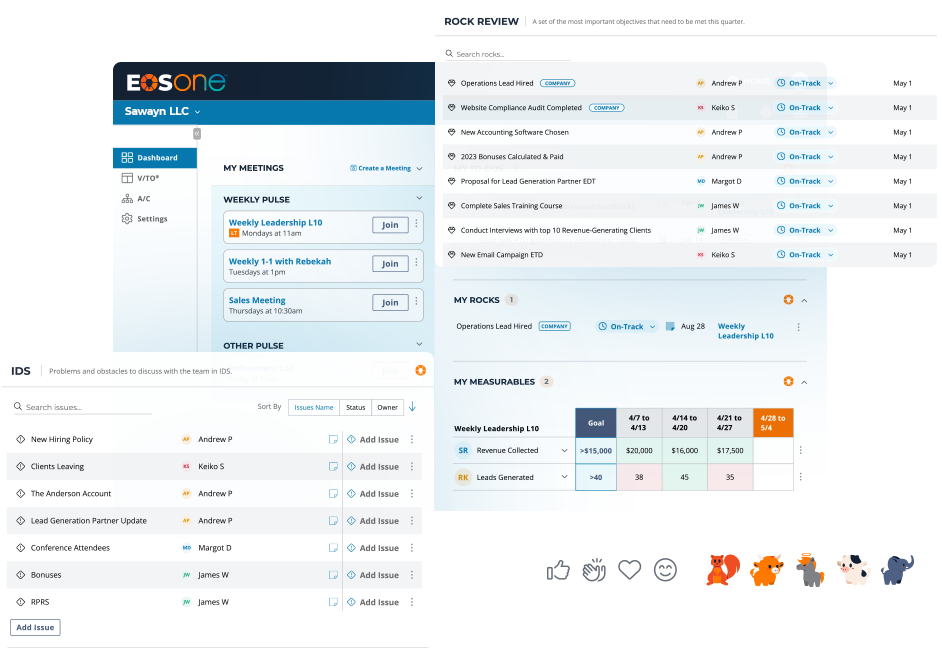
One of our toughest battles as entrepreneurs can be keeping our best people. As business owners and leaders, most of us have felt the pain of losing that valued team member. The one who had tribal knowledge, knew every customer, and could solve any problem whenever it arose. That turnover hurts, but we know it’s not isolated.
Why Turnover Hurts So Much
Apart from the hit to morale from losing a teammate, turnover hurts your business in additional ways. For example, depending on the role, replacing an employee can cost you between $20,000 and $75,000. Plus, the time and resources required to find and train new hires continue to increase.
In addition, the younger the employee, the more likely they will leave sooner rather than later. In addition, our staff continue to expect more from us as owners. They’re paying closer attention to the actions of their leaders and managers.
How Can EOS Help?
So, how can we use EOS tools and disciplines to avoid the perils of turnover and retain our key staff?
1. Right People, Right Seats
Of course, the journey to having the Right People in the Right Seats can be difficult. No one gets it right the first time, but the returns can be significant, and they’re worth the effort.
How can you keep your best people? First, only hire someone who fits your culture. Then, make sure they sit in seats where they can win while helping the greater good of the organization. Hiring the Right People for the Right Seats fosters those good vibes to get great results!
You and your leadership team will likely need to put in hard work. You’ll need to have tough conversations and get clear on your culture and who belongs on your team. Your RIGHT PEOPLE want to be around others with a similar disposition, which will keep them with you longer.
2. Vision/Traction Organizer®
Next, you’ll want to communicate your vision regularly (like at your quarterly all-employee meeting) by sharing your Vision/Traction Organizer (V/TO®). Reviewing the V/TO allows you to spell out where your company is heading and defines the “greater good” for your staff.
In addition to sharing it every 90 days, return to it and review it with your people whenever the opportunity arises. Most employees truly care about being able to finish what they started. So, as passionately and as frequently as you can, make sure each person knows how they’re part of that journey!
Quick tip (inspired by one of my clients): Place a new copy of your V/TO on every staff member’s desk (or in their inbox) every quarter!
3. Voluntary Turnover
Most of us have shuddered in situations where we anticipated needing to remove individuals from our team. Turnarounds for individuals who don’t appear to be the right person for the right seat regularly occur. But sometimes that’s not possible. In that case, supporting those individuals in finding a better workplace home can be a win/win.
Be upfront with the person if you think they’re not a Core Values fit or don’t GWC™ (Get, Want, Have Capacity) for their seat. As leaders, we have an opportunity to be humble and empathetic when it becomes obvious someone is unsuitable for their seat.
Your Right People will take note of how you handle difficult situations. And they’ll appreciate leaders who protect the team.
Hot Tips for Working with Younger Staff
Finally, here are some quick tips to help keep your younger staff. (P.S. These tips can also work with less-younger staff, too.)
1. Be Open and Direct
Younger generations entering the workplace are often very focused on fairness. Many have a higher propensity to be open, even with senior leaders. Despite widespread rumors, younger staff can receive positive or negative comments without crumbling into a heap. They’ll value frank discussion.
2. Authenticity
Be transparent, candid, and, more importantly, just be yourself. Younger staff pay close attention to how someone’s actions align with their personality. They notice if a person is trying to be someone they’re not.
3. Purpose
Younger employees increasingly focus on organizations and their leaders’ visions. Take time to connect small and large decisions to your Core Focus. The big picture and wider impact of a decision will likely be of great interest.
4. Measurables
In particular, recent grads have been trained to be accountable to numbers (aka grades). Use your Measurables to set expectations and showcase winning performance.
Reduce Turnover
The EOS Tools offer a great way to communicate with your staff to reduce turnover. A leader can do many small things that make a big difference: be bold, regularly communicate the company’s vision, and be open and honest. Increase transparency by using EOS One™, the one official software for running your business on EOS.
Your young and not-as-young staff will appreciate you for it and be more likely to stay in their seat.






